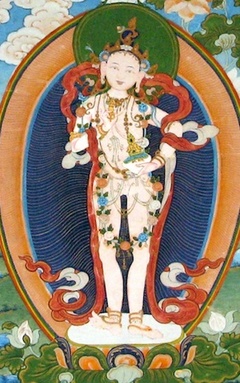Ḍāki Mengak Gabtik
English | Deutsch | Español | Français | བོད་ཡིག
༁ྂ༔ ཌཱཀྐིའི་མན་ངག་གབ་ཏིག་བཞུགས༔
The Secret Drop, the Heart-Instruction of the Ḍākinīs
revealed by Tertön Sogyal Lerab Lingpa
༁ྂ༔ མཁའ་འགྲོའི་བྱེ་བྲག་བསམ་ཡས་རྣམས༔ རྡོ་རྗེ་ཕག་མོ་མཚོ་རྒྱལ་གྱི༔ ངོ་བོར་དྲིལ་ཏེ་སྒོམ་སྒྲུབ་བྱ༔
The different varieties of ḍākinīs defy the imagination, but they are all essentialized in Vajravārāhī and Yeshé Tsogyal, and this is how to accomplish their practice:
Taking Refuge and Awakening Bodhicitta
བཅོམ་ལྡན་རྡོ་རྗེ་ཕག་མོ་དང་༔
chomden dorjé pakmo dang
O Vajravārāhī, Enlightened Lady,
བདེ་ཆེན་མཚོ་རྒྱལ་ཞབས་པད་ལ༔
dechen tsogyal zhabpé la
And Yeshé Tsogyal, Queen of Great Bliss, at your lotus feet
སྙིང་ནས་གུས་བཏུད་སྐྱབས་སུ་གཟུང་༔
nying né gütü kyab su zung
I pay homage, my heart full of devotion: Be my refuge!
རྣམ་གྲོལ་བྱང་ཆུབ་སེམས་མཆོག་བསྐྱེད༔
namdrol changchub sem chok kyé
I generate the supreme awakened mind, the bodhicitta of total liberation!
Three times
The Visualization
སྣང་སྲིད་སྣོད་བཅུད་ཐམས་ཅད་ཀུན༔
nangsi nöchü tamché kün
All appearance and existence, universe and beings,
བདེ་སྟོང་དག་པ་ཆེན་པོའི་ཞིང་༔
detong dakpa chenpö zhing
Are a realm of all-inclusive purity, of bliss and emptiness,
ཕྱི་ནང་གསང་མཆོད་བླ་མེད་པ༔
chi nang sang chö lamepa
Where offerings unsurpassed, outer, inner and secret,
མ་བཀོད་རང་ཤར་ལྷུན་གྱིས་གྲུབ༔
makö rangshar lhün gyi drub
Have no need to be contrived, but are naturally present, in spontaneous perfection.
རང་སྣང་ཞིང་མཆོག་ཉམས་དགའི་དབུས༔
rangnang zhing chok nyamgé ü
This sublime, enchanting realm becomes my whole perception:
ཆུ་སྐྱེས་གེ་སར་ཉི་ཟླའི་སྟེང་༔
chukyé gesar nyidé teng
At its heart, on a lotus flower blossoming from the waters of a lake, on a cushion of discs of sun and moon,
བདག་ཉིད་མཚོ་རྒྱལ་དཀར་དམར་མཛེས༔
daknyi tsogyal kar mar dzé
I am Yeshé Tsogyal, beautiful, white and tinged with red,
ཞི་འཛུམ་གཞོན་ཚུལ་བདེ་བ་རྒྱས༔
zhi dzum zhön tsul dewa gyé
Peacefully smiling, youthful, and seductive,
གཅེར་མོ་རིན་ཆེན་རུས་རྒྱན་ཅན༔
chermo rinchen rügyen chen
Naked, with jewel and bone ornaments,
གཡས་བསྐུམ་གཡོན་བརྐྱང་གར་གྱིས་བཞེངས༔
yé kum yön kyang gar gyi zheng
Dancing, poised on her left leg, with her right leg bent inwards.
གུ་རུ་བདེ་ཆེན་རོལ་པའི་སྐུ༔
guru dechen rolpé ku
Symbolizing Guru Rinpoche, in his body of great bliss,
གསེར་གྱི་རྡོ་རྗེ་རྩེ་ལྔའི་ཚུལ༔
ser gyi dorjé tsé ngé tsul
She holds a five-pointed golden vajra
གཡས་ཀྱི་ཕྱག་གིས་ཐུགས་ཀར་འཛིན༔
yé kyi chak gi tukkar dzin
In her right hand at her heart
ཚེ་འཛིན་ལྷ་ལྕམ་མནྡ་ར༔
tsendzin lhacham mandara
And to symbolize the princess Mandāravā, who commands long life,
ཚེ་བུམ་རྣམ་པ་གཡོན་ན་བསྣམས༔
tsebum nampa yön na nam
She holds a long life vase in her left hand.
དབུ་སྐྲ་མཐོན་མཐིང་ཐོར་ཚུགས་བཅིང་༔
utra tönting tortsuk ching
Her hair is deep blue, some tied up above,
ལྷག་མ་སྐུ་རྒྱབ་སིལ་བུར་འཕྱངས༔
lhakma kugyab silbur chang
The rest tumbling and waving in tresses behind her,
རང་མདངས་འཇའ་འོད་གུར་ཁྱིམ་ཀློང་༔
rang dang ja ö gurkhyim long
Her own radiance encircles her in a sphere of rainbow light.
ཡེ་ཤེས་འོད་སྐུར་ལྷང་ངེར་གསལ༔
yeshe ökur lhang nger sal
Vivid and brilliant she appears, a body of wisdom light.
ཙིཏྟ་རིན་ཆེན་འོད་འབར་དབུས༔
tsitta rinchen öbar ü
At her heart, in a blazing jewel of light,
པད་ཉི་བམ་རོ་བརྩེགས་པའི་སྟེང་༔
pé nyi bamro tsekpé teng
On a lotus, a sun disc, and then a corpse,
རྡོ་རྗེ་ཕག་མོ་རཱ་གའི་མདོག༔
dorjé pakmo ragé dok
Stands Vajravārāhī, rich ruby red,
ཁྲོ་འཛུམ་སྤྱན་གསུམ་བདེ་བའི་ཉམས༔
tro dzum chen sum dewé nyam
With a wrathful smile, and three eyes, in a rapture of bliss,
རྣ་ལྟག་གཡས་སུ་ཕག་ཞལ་ངུར༔
natak yé su pak zhal ngur
On the right side of her head grunts the head of a sow.
གྲི་ཐོད་འཛིན་ཅིང་བརྐྱང་བསྐུམ་བཞེངས༔
dri tö dzin ching kyangkum zheng
Holding hooked knife and skull-cup, and in dancing pose,
ལྷན་སྐྱེས་བདེ་ཆེན་དག་པའི་སྐུ༔
lhenkyé dechen dakpé ku
The pure body of co-emergent great bliss,
དམ་ཡེ་གཉིས་སུ་མེད་པར་བསྒོམ༔
damyé nyisu mepar gom
I imagine samayasattva and jñānasattva indivisible.
རང་བྱུང་བྷནྡྷའི་སྣོད་ཡངས་སུ༔
rangjung bhendhé nö yang su
A vast skull-cup appears naturally, of its own accord,
ཤ་ལྔ་བདུད་རྩི་ཆེན་པོ་ལྔ༔
sha nga dütsi chenpo nga
In which are the five meats, and the five great nectars;
སེམས་ཀྱི་ཡིད་བཞིན་སྤྲིན་ཚོགས་གཏིབས༔
sem kyi yizhin trin tsok tib
Clouds of everything to fulfil the mind’s desire
མི་ཟད་རྒྱན་གྱི་འཁོར་ལོར་གྱུར༔
mizé gyen gyi khorlor gyur
Gather and transform into an inexhaustible flow of beauty.
སྐུ་གསུམ་རབ་འབྱམས་ཞིང་རྣམས་དང་༔
ku sum rabjam zhing nam dang
From the limitless realms of the three kāyas;
གནས་ཡུལ་དུར་ཁྲོད་མཁའ་སྤྱོད་ནས༔
neyul durtrö khachö né
From power places, charnel grounds and domains of space,
རྩ་གསུམ་དཔའ་བོ་མཁའ་འགྲོའི་ཚོགས༔
tsa sum pawo khandrö tsok
Vast throng of the Three Roots, vīras and ḍākinīs,
བདེ་བའི་གར་གྱིས་འདིར་བྱོན་འཚལ༔
dewé gar gyi dir jön tsal
Dancing in bliss, come, now, to this place!
ཟག་མེད་འདོད་འབྱུང་ལོངས་སྤྱོད་བཞེས༔
zakmé dö jung longchö zhé
Accept and enjoy these sumptuous objects of untainted desire!
ཀུན་ཀྱང་བདེ་བའི་ངོ་བོར་ཞུ༔
kün kyang dewé ngowor zhu
All now melt into the essence of bliss,
རང་ལ་ཐིམ་པས་རྡོ་རྗེའི་སྐུ༔
rang la timpé dorjé ku
And dissolve into me, granting me spontaneously the indestructible vajra body, which is
མི་འགྱུར་བདེ་བ་ཆེན་པོའི་དངོས༔
mingyur dewa chenpö ngö
The actual essence of unchanging great bliss,
རྒྱལ་བ་ཀུན་དང་རོ་གཅིག་པའི༔
gyalwa kün dang ro chikpé
The wisdom which is one taste with
ཡེ་ཤེས་ལྷུན་གྱིས་གྲུབ་པར་གྱུར༔
yeshe lhün gyi drubpar gyur
All the victorious buddhas.
ཨོཾ་པདྨོ་ཡོ་གི་ནི་གུཧྱ་ཛྙཱ་ན་བཛྲ་ཝ་ར་ཧི་མ་ཧཱ་སུ་ཁ་སརྦ་སིདྡྷི་ཧཱུྃ༔
om pemo yogini guhya jnana benza varahi maha sukha sarva siddhi hung
oṃ padmo-yoginī guhya-jñāna vajravārāhī mahāsukha sarva-siddhi hūṃ
དེ་ཡིས་ཡེ་ཤེས་མཁའ་འགྲོ་མ༔ མྱུར་དུ་འགྲུབ་ངེས་ས་མ་ཡ༔
With this you will be certain to accomplish the Wisdom Ḍākinī. Samaya!
| © Rigpa Translations. Reproduced with permission.
Version: 1.0-20230410
